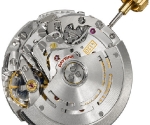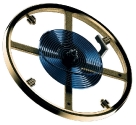Haute Horlogerie and ‘Haute Motoring’ seem to go hand in hand. One who likes the mechanics and craftsmanship of a wrist watch, is most likely also interested in high end motoring which comes down to impressive (in most cases) mechanics and technology as well. With the ‘Wednesday Watchday’ here at Motoring Exposure, we will try and see whether this is also vice versa. Motoring freaks keeping track of interesting time keeping machinery.
Let’s start with – perhaps – the cult watch of driver’s watches, used by many racing drivers (in movies and in real life), the Rolex Cosmograph Datyona. We are talking about the ref. 116505 here, since Rolex recently started putting an extra 1 in front of the old reference numbers, to show things has changed last decade. This time piece is a 40mm in-house movement powered chronograph, black dial, water resistant till 100 meters and using a special alloy called Everose gold (patented by Rolex ofcourse). As you’d already suspect, Everose means that the rose (sometimes referred to as red) gold stays forever. Where normal rose gold will fade away to yellow after years of wear and tear, Rolex made sure that this new Everose alloy will stay rose gold coloured. It short, it comes down to this: Rolex uses platinum to shield the rose gold against wearing off after time.
Since the year 2000, Rolex started using their own in-house movements for the Cosmograph Daytona. Before that, Rolex used Zenith movements for about a decade and before that, hand wound Valjoux movements. The Zenith movements were the famous El Primero movements, especially tailored for Rolex to meet their specific requirements. The current Rolex chronograph movement caliber 4130 consists of 290 parts, fewer then in many other chronographs out there. It also uses the new and innovative Parachrom hairspring, 10x more resistant to shocks than other hairsprings and due to the use of a special alloy, it isn’t affected by magnetic fields. Rolex uses clever engineered and relatively basic constructed movements, up to the task and finished in a way that is near perfection.
Furthermore, up until recently I am very sure you had your doubts when holding a Rolex Oyster bracelet for the first time, right? Flimsy look & feel and an awful cheap looking folding clasp. Check again! The new line-up of Rolex is featuring a solid link bracelet and using this new method of adjusting the bracelet in size, without having to use screw drivers or tooth picks. Although the old Oyster bracelet never failed on me, I am looking forward having a Rolex with this bracelet and clasp.
Who said Rolex isn’t innovative?
This watch will join you on racing tracks for 23.450 euro +/- $35k, enabling you to time your rounds in style. Normal motoring allowed as well.
Rolex Cosmograph Daytona Everose Gold
[Pictures courtesy of Rolex SA.]









